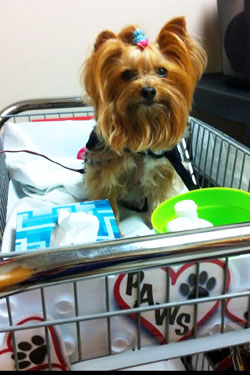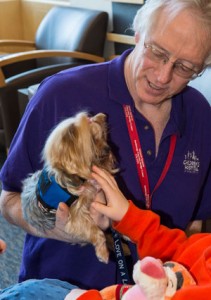
Anyone who makes a home for a pet knows the benefits of the best animal interactions: companionship, unconditional love, warmth, friendliness, a gentle curiosity.
Those benefits have not escaped human health experts. Study after study shows that humans who care for pets reap health benefits, from more exercise to lower stress levels.
“The human-animal bond is a unique, mutually beneficial relationship between people and animals; it has a major impact on the health and well-being of both. This includes, but is not limited to, emotional, psychological, and physical interactions of people, animals and the environment.” – American Veterinary Medical Association’s Committee, 1998

Dogs as therapy companions became a reality in Anchorage in 1998 when Anchorage-ite Mary Troll began a pilot program to bring dogs for visits in the Children’s Hospital at Providence. In 2006, the program became official and was called Pet Assisted Wellness Services, or PAWS.
Today that service has grown from three teams visiting just one area of the hospital, to 29 teams visiting 15 different areas of the hospital and totaling up to 16,400 canine connections a year.
There are rules, standards and protocols. On today’s Hometown Alaska we’ll meet Laure MacConnell, coordinator of the PAWS program, to learn how it works. How are the teams (human and animal) trained? What about cleanliness? What about hospitals, can’t they be scary places with strange smells and sounds? Is it healthy for the dogs?
We’ll hear from a visiting team, locals Mike Lewis and Jillie, one of two Yorkshire Terrier therapy dogs. Mike has been offering therapy dog visits for six years.

We’ll learn a bit about Pet Partners, a national organization founded in 1977 by veterinarians that provides appropriate standards. Pet Partners provides preliminary training and screening tools prior to the advance training PAWS’ therapy animal program volunteers receive after they join Providence. And according to MacConnell, other local health organizations are tapping into this national resource to begin their own therapy animal programs.
Do you have a pet who might make a good therapy animal? Find out how from the experts. Or have you benefited personally from a therapy visit when you were in a health care facility? We’d love to hear your story.
HOST: Kathleen McCoy
GUESTS:
- Laure MacConnell, coordinator of PAWS at Providence Hospital, along with her dog Remy
- Mike Lewis and Jillie, a patient-visiting team

LINKS:
- PAWS program, Providence Health & Services
- Love on a Leash (9 min. video)
- Canine Good Citizenship training, part of preparing a therapy dog
- Pet Partners.org, largest nonprofit training volunteer teams
- FAQ on therapy dogs, Pet Partners
- Team profiles, Pet Partners online magazine
- Dog evaluation points, Pet Partners
- Therapy dogs boost health of sick and lonely, National Geographic News
- Doctoral thesis (182 page PDF), including survey of studies confirming health impacts of human-animal interactions
- When age has no leash, Alaska Dispatch News
PARTICIPATE:
- Call 550-8433 (Anchorage) or 1-888-353-5752 (statewide) during the live broadcast (2:00 – 3:00pm)
- Send email to hometown@alaskapublic.org before, during or after the live broadcast (e-mails may be read on air)
- Post your comment or question below (comments may be read on air)
LIVE BROADCAST: Wednesday, December 3, 2014. 2:00 – 3:00 p.m. (Alaska time)
REPEAT BROADCAST: Wednesday, December 3, 2014. 9:00 – 10:00 p.m. (Alaska time)
SUBSCRIBE: Get Hometown, Alaska updates automatically — via email, RSS or podcasts




